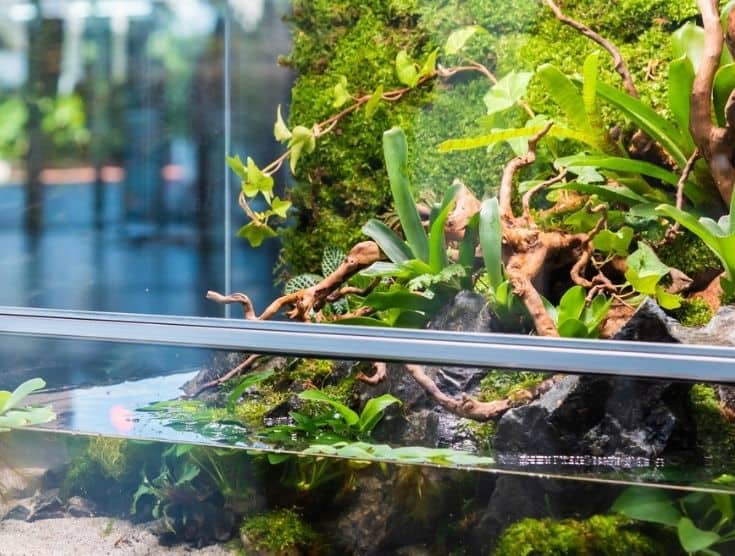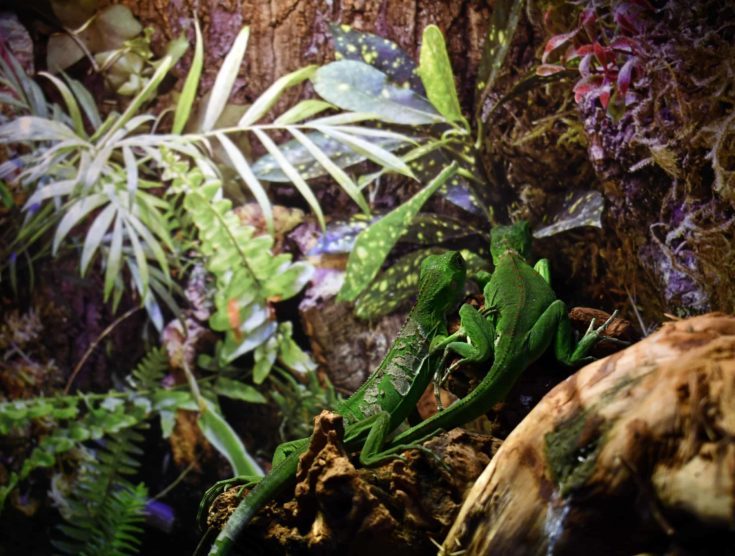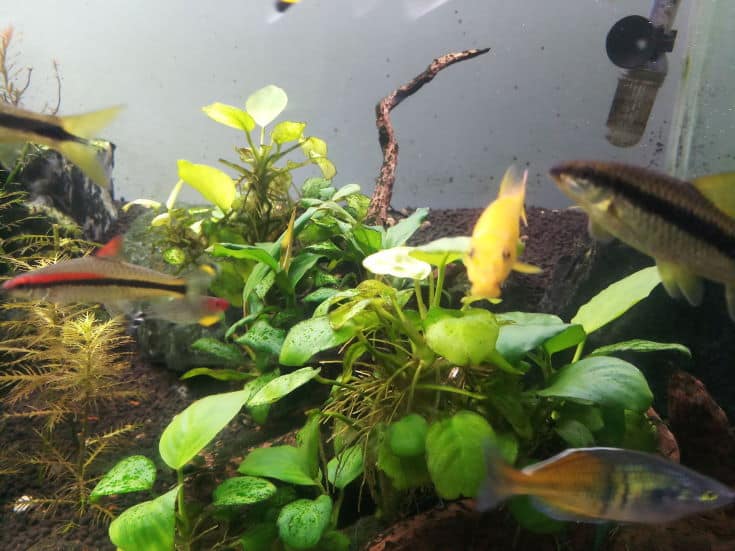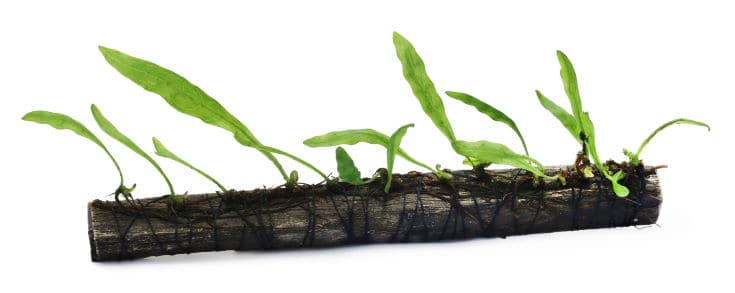What is a riparium? What is a paludarium? And what are the differences between the two?
So, you know that both are glass vessels that are used to keep and cultivate living plants, but there’s a whole lot more to it than that! In this comparison article, we look closely at the definition of a riparium vs. a paludarium.
Read on to learn the differences and similarities between a riparium and a paludarium, plus a whole lot more interesting facts about them!
What’s The Difference Between A Riparium And A Paludarium?
Both a riparium and a paludarium are kept in glass tanks or containers and may be open or closed.
In a paludarium, you generally keep all species of plants, including floating, submerged, or terrestrial species. A paludarium is built with a hardscape to support the plants and semi-aquatic animals such as turtles.
A riparium is a more aquatic environment with a limited amount of landmass and is designed to resemble a riverbank or coastal environment.
Comparison Table
Riparium

Tank/Aquarium Types
Glass
Filter (Needed/Not Needed)
Filter required
Biotopes
Coastal or riverbank
Humidity Level
Moderate
Paludarium

Tank/Aquarium Types
Glass
Filter (Needed/Not Needed)
Filter required
Biotopes
Swamp or jungle
Humidity Level
High
There are many different types of vivariums of which ripariums and paludariums are just two.
Although these two forms of vivariums look similar at first, there are some notable differences. Both are made from glass vessels of various sizes, and both are primarily used by aquascapers to grow aquatic and semi-aquatic plants.
Paludariums are traditionally used to create a jungle or swamp kind of habitat that includes areas of “land” where animals can live, whereas a riparium recreates a riverbank environment of mostly plants and perhaps a few small fish.
Now, let’s take a look at a direct comparison between a riparium and a paludarium.
Riparium
So, what is a riparium, and what is it used for?
- A riparium is pretty much a hybrid version of an aquarium and a paludarium.
- Ripariums contain very little “land” and are purely an aquatic environment that can house fish but no semi-aquatic animals.
- Ripariums don’t require high humidity levels.
- Ripariums can demand CO2 injections, especially if the plants chosen are medium to high light species.
- A riparium needs a filter to keep the water clean for the fish that live there.
- Ripariums are usually open-top glass containers.
Paludarium
And how about a paludarium?
- A paludarium includes around 80% of plants together with a large amount of water.
- Paludariums generally replicate a particular ecosystem that’s found naturally.
- A paludarium contains an amount of terrestrial material where semi-aquatic creatures can live.
- Semi-aquatic animals are typically kept in a paludarium, including frogs, turtles, and salamanders.
- Paludariums require a high level of humidity.
- A paludarium needs a filtration system to maintain good water quality for the animals or fish that are living there.
- Paludariums are glass vessels that are sometimes open-topped, depending on what creatures are housed within the vivarium.
What Are The Pros And Cons Of Ripariums And Paludariums?
There are a few pros and cons to both these vivarium types:
Riparium Advantages
- Ripariums are fabulous for hobbyists who are new to growing plants. Keeping a riparium gives you the opportunity to grow lots of easy-to-grow aquatic species.
- If you grow emersed aquatic plants in a riparium, they’ll get unlimited atmospheric CO2. That means you’ll get to see flowers and large, colorful leaves that you don’t get in a regular aquarium.
- Whereas an aquarium is designed to be viewed from the front and sides, a riparium gives you a spectacular view from above, especially if some plants grow out of the top, creating a real “wow” factor.
And Disadvantages …
- If you keep an open-top riparium, you’ll notice faster evaporation than you get with a covered setup.
- A covered riparium limits what taller plants you can grow.
- If you keep an open-top riparium, any plants that are exposed to the air can be vulnerable to attack by pests such as spider mites, aphids, and scale.
- Although emersed plants will grow vigorously thanks to the high levels of CO2 they have access to, that also means you need to prune them frequently. Depending on what you grow, you might also need to carry out root division. Also, tall plants can create a kind of canopy effect that deprives low-growing species of light, potentially retarding their growth.
Paludarium Advantages
- You can grow a wide variety of emersed and aquatic plants.
- You can keep semi-aquatic animals in a paludarium as well as plants. That gives you a greater variety of options when it comes to your setup.
- If you keep an open-top paludarium, your plants will enjoy unlimited CO2 and should flourish.
- An open-top paludarium can be viewed from above as well as the front and sides, making this kind of setup much more appealing than a standard aquarium.
And Disadvantages …
- Your choice of plants may be limited, depending on what wildlife you decide to keep, as some creatures might eat tender plant shoots.
- If you keep animals that are escape artists, you’ll need to have a paludarium setup with a lid that will limit your view of the plants.
- As with any planted setup, you’ll need to carry out regular pruning, thinning out, and other general maintenance tasks. In an open-top tank, that can be amplified if your plants grow vigorously because of the additional CO2 they have access to.
- Paludariums are generally more maintenance-heavy than ripariums because the animals you keep tend to create more mess.
What Plants Can You Keep In A Riparium Vs. A Paludarium?

When it comes to the plant species that you can grow in a riparium vs. and paludarium, there are some similarities and differences:
Ripariums
As previously mentioned, ripariums are intended to recreate a coastal biotope. You can use many aquatic, pond, and marginal species, although some will grow completely out of the water provided that the humidity is high enough.
Aquatic plants that I recommend for a riparium include:
- Amazon Swords
- Java Fern
- Java Moss
- Cryptocoryne
- Anubias

You can also grow Water Sprite floating or rooted in the substrate.
When it comes to marginal species, some plants that are suitable for your riparium include:
- Crimson Ivy (Hemigraphis colorata)
- Umbrella papyrus
- Peace Lily (Spathyphyllum)
- Dracaena
You can also grow Amazon Swords as marginal plants.
Pond plants that you can include in your riparium include species of tropical water lilies such as Lotus and Nymphaea stellata.
Paludariums
In a paludarium, you can grow a mix of aquatic, terrestrial, and semi-aquatic plant species. The plants you choose will depend on how much time you want to devote to their maintenance and on whether you want to recreate a specific regional or local biotope habitat or you’re happy to simply grow a wide range of beautiful plants.
Even if you’re not too concerned about what plants you grow relative to the habitat you’re creating, you must ensure that whatever species you choose won’t be harmful to the animals you want to keep. Also, bear in mind that any plants that are viewed as a food source will require regular replacement, which might prove expensive in the long term.
A few ideas for plants to grow in your paludarium include:
- Vines, devil’s ivy, and creeping fig are perfect for covering the back wall of the setup
- Boston fern, Holly fern, Lemon Button fern are good space fillers
- Bromeliads are ideal if you’re keeping frogs
- Java moss
- Small orchid species
- Carnivorous plants, including Utricularia and Pinguicula
- Java fern
- Anubias
- Cryptocoryne
Floating plants, including Salvinia, also work very well in a paludarium setting.
What Creatures Are Suitable For A Riparium?
Pretty much any aquatic creatures will do well in your riparium. However, whether you’re recreating a brackish Everglades habitat or a freshwater riverbank setting in Delaware, do check that all the creatures you’re considering keeping can peacefully coexist together and will tolerate the same water conditions.
Many species of nano fish, together with bottom-dwelling scavengers such as Plecos and catfish, make a good community, and Archerfish are always entertaining to watch as they shoot jets of water at resting insects, knocking them into the water for a meal. Small crayfish and other crustaceans can also be an interesting addition.
What Animals And Fish Can Live In A Paludarium?
Again, whatever animals and fish you choose must get along together and share the same water parameters. So, do your research to make sure that any carnivores you want to keep won’t eat any of your other exhibits!
Nano fish such as Guppies and Mollies work well in a paludarium, as well as catfish, and you can keep a wide variety of animals too, including:
- Geckos
- Dart frogs
- Salamanders
- Turtles
- Shrimp
- Crabs
- Springtails
- Isopods
If you want to recreate a specific habitat, I strongly recommend that you do your research into the plants and animals that live there, and make sure that everyone gets along.
In Conclusion
I hope you enjoyed this comparison of ripariums and paludariums. If you did, please remember to share!
A riparium is generally used to keep a wide range of tropical plant species and contains more water than “land.” Fish and crustaceans can also be added to give the habitat life and interest. A paludarium contains more terra firma than a riparium, so you can keep semi-aquatic animals, as well as fish and lots of plants.
Do you keep a riparium or paludarium? We’d love to know what fish and animals you keep and what specific biotope you’ve recreated.
Tell us what you’ve achieved in the comments box below!